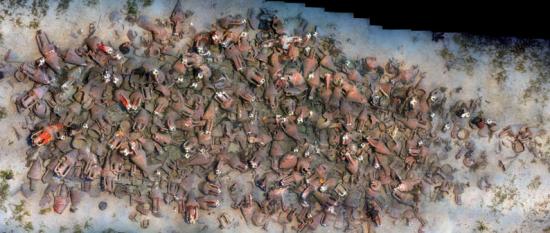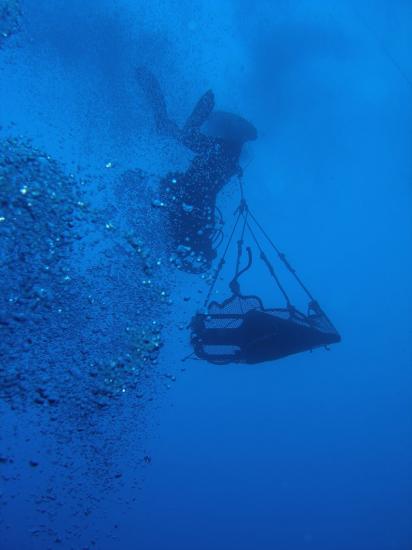Nathan Morley
Source - http://cyprus-mail.com/2016/02/07/a-wreck-of-historic-importance/?
 An ancient shipwreck off the southern coast is yielding fascinating artefacts that provide a remarkable record of ancient sea trade between the Aegean Sea and Cyprus.
An ancient shipwreck off the southern coast is yielding fascinating artefacts that provide a remarkable record of ancient sea trade between the Aegean Sea and Cyprus.
It’s like “excavating a time-capsule”, says director of the project, Dr Stella Demesticha, associate professor at the University of Cyprus, describing the Mazotos shipwreck and the details it is revealing about maritime life in the region over 2,000 years ago.
It was discovered in 2007 and sits at a depth of 45 metres off the coast of Mazotos in Larnaca. Having sat undisturbed in its silent, watery grave since the 4th century BC the wreck has caused a buzz in the archaeological community.
 “The Mazotos shipwreck is special for many reasons,” says Demesticha.
“The Mazotos shipwreck is special for many reasons,” says Demesticha.
“First of all, it belongs to the rare class of ancient shipwrecks that can be characterised as coherent – meaning they preserve their internal stratigraphy. Such wrecks can provide unique insights into seafaring, seaborne trade and shipbuilding in antiquity.”
To put things into perspective, the ship sank at about the time the Romans built their first aqueduct and before the conquests of Alexander the Great shook the region. It set sail on its ill-fated voyage during the height of the Classical Greek civilisation, as philosophy, literature and architecture were spreading far and wide.
“We study the ship itself, although very little has been exposed thus far: its size, its anchors as well as the methods and materials of construction. We focus on the wine amphorae of the cargo, which are thoroughly documented before and after recovery,” Demesticha added.
Amphorae are the tall ceramic containers with thin handles and a narrow neck and pointed base which were usually used to transport wines, oils, water and sauces on ships.
The wreck is considered to be of historic importance, and excavation is being conducted by the Archaeological Research Unit at the University of Cyprus along with the Department of Antiquities.
The collaboration of these institutions marks a first in local underwater archaeology, as no foreign organisations are involved.
What makes this discovery special is its incredible state of preservation, which classifies the site among the rare cases of shipwrecks in the Mediterranean.
Since being discovered, the wreck has yielded a rich trove of wine amphorae – thought to come from the Greek island of Chios.
Around 500 visible amphorae are scattered over an area of almost flat seabed – remarkably, four layers of the ceramic jugs are preserved in their original stowage position.
Other artefacts include lead stocks, the remains of three anchors, a large number of olive pits and even the keel and structural timbers. Organic materials – such as the remains of the crew, textiles and fittings – have long since disintegrated.
The team anticipates more discoveries and insights will be revealed from beneath the deep layers of silt and mud.
The mystery of how or why the merchant ship foundered will never be known, but Demesticha argues that she probably sank after waves and sea spray filled the bilge.
“The reason of a wreck in the open sea, like this one, which does not involve capsizing, most probably is the water in the ship because of a storm and high waves.”
It is also likely that all hands would have gone down with the ship.
The job of conducting surface surveys and mapping the wreck is complex, says surveying engineer and diver Dr.Dimitrios Skarlatos, assistant professor at the Cyprus University of Technology.
“When we started there were several clear limitations with the underwater environment, and several challenges. It may sound trivial, but prior to any finding removal, the exact position of it should be recorded and documented. Therefore, the survey should be daily, detailed, robust, quick and accurate to the centimetre,” said Skarlatos who has been involved in the wreck documentation since 2010.
“Acquisition time had to be less than twenty minutes, which is the bottom time for the divers. The final result must be both accurate and very detailed, while the processing time is limited, from dusk till dawn of the next day.”
According to Skarlatos the real challenge was to understand the peculiarities of the underwater environment in order to propose an accurate acquisition method.
The team used computer vision techniques to fully automate the photogrammetric processing.
“That way, within the given time we could process hundreds of photos and produce millions of points within an afternoon,” he added.
Mazotos was the first reported shipwreck where the photogrammetry was merged with computer vision to produce dense colour point clouds, changing completely the way underwater documentation is being conducted worldwide.
Conservation of the finds requires specialised personnel. The laboratory for the conservation of maritime antiquities was created by the Department of Antiquities and is supervised by the conservator Eleni Loizidou and is where all the excavated material is being kept and conserved.
Once brought to the surface, the finds are desalinated through immersion and their surface is cleaned mechanically.
As it stands there are no immediate plans to raise the vessel.
“At this depth and without the proper conservation infrastructures on land, bringing up the vessel is not an option,” says Demesticha. “While working with the Department of Antiquities towards that direction, we will continue with the recovery of the cargo.”
However, the team is not ruling out that other wrecks are sitting on the seabed in this region waiting to be discovered.
“We can assume that there should be undiscovered wrecks in Cyprus. The archaeological significance of those may vary though. Using combination of aerial Lidar surveys and multi beam echo sounders to scan the sea bottom we will for sure discover more. We are currently working towards that direction,” Skarlatos says.
The excavation has been made possible with the support of many sponsors; the Honor Frost Foundation, from the UK and CYTA from Cyprus are among the most important ones.
Apart from funding, the project is in constant need of human resources with a significant number of volunteers coming from many different countries every year to join forces with the main team.
